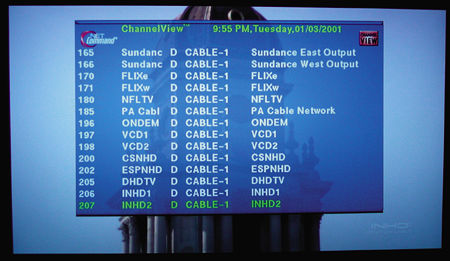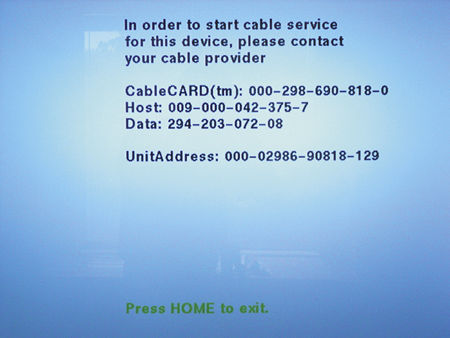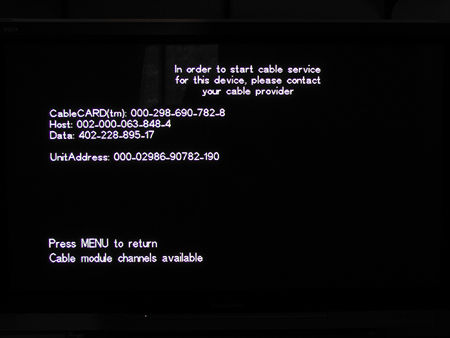Outside the Box Page 2
Here's where things got a bit weird. In the WD-52525's setup menu, the default labels for each antenna input are (in the same order listed above) Air and Cable. But digital cable will work only through the first (Air) input; if you do that, you'll have to use the second (Cable) input for off-air digital reception. This means you can't do a channel scan through the Air input (unnecessary with CableCARD), but you can do a channel scan for off-air signals through the Cable input. If it took me a moment to figure out what was going on here, I'm sure this menu labeling will confuse some consumers, and may result in more than a few calls to cable-company customer service representatives.

Mitsubishi provides a full listing of all available digital cable channels, while Panasonic doesn't.
The WD-52525's off-air digital channel scan (unlike the TH-42PD25's) took so long that I set it up and went out to pick up lunch and run a few errands. I would guess it took the better part of 15 minutes to complete the scan, but there's no reason for it to take that long. Most current, fourth-generation off-air digital TV tuners can do a complete scan of channels 2 through 69 in less than 90 seconds. The digital data that identify each station, which video and audio formats are in use, and basic time and date information, are captured very quickly. (One of my lab reference set-top tuners, LG's LST-3100A, does a complete digital channel scan in 30 seconds.)
Once both TVs had completed their scans, I was able to navigate quickly among cable channels, change antenna inputs, and hop from one off-air channel to another. The WD-52525 had a distinct advantage here in providing a list of available channels to surf when I pushed its Guide button. I merely scrolled to the desired channel and pushed Enter.
The TH-42PD25's channel selection is a bit more simplistic—you either input the cable or off-air channel number directly and push Enter, or use the Channel Up/Down button. The Panasonic doesn't provide a detailed channel list. You have to build your own channel-surf list from both RF inputs, with a maximum of 16 entries.
Given how new each of these TVs is, it stands to reason that both use the latest fourth-generation 8VSB chipsets (at this time, only LG has the new, fifth-generation versions in its integrated digital TVs). Using the same rooftop antenna, I figured both sets would capture the same list of off-air digital channels—and they did. Both pulled in 11 available off-air digital stations and 23 minor channels of programming.

Here's what you see on the WD-52525 before your cable company enables the CableCARD.
Surfing wasn't difficult—you use the Device selection on the WD-52525's remote to move back and forth between cable and off-air, and, on the TH-42PD25's remote, toggle between antennas A or B. To get around faster on the Panasonic you can, of course, build a surf mix that includes digital cable and off-air stations.
Other Notes
I mentioned earlier that you couldn't pull a CableCARD from one TV, plug it into another, and expect it to work. In the interests of science, I pulled the card that had been set up for the TH-42PD25 and plugged it into the CableCARD slot on Sharp's LC-45GX6U 45-inch LCD TV. "call your cable company to activate this card," said the Sharp's screen.
Nor, once switched, would the CableCARD work correctly when I plugged it back into the Panasonic TH-42PD25, for which it had been originally authorized. That's because at least one number key (Data) had changed as a result of my experiment. I had to call Comcast and have them re-enter the four sets of numbers to restore service to the TH-42PD25.
Both sets offer other analog and digital inputs for viewing cable programming, should you want to use an existing cable set-top receiver and get the benefit of full EPG. On either of the test TVs, you can do that through analog Y-Pb-Pr connections, a 15-pin RGB connection, or an HDMI jack.

The TH-42PD25's OSD is pretty much the same when you first plug in the CableCARD.
The WD-52525 also provides FireWire connections under the NetCommand name. You can use these to control other devices and record digital programs to FireWire-equipped devices, subject to copy-protection restrictions transmitted by each digital channel. No such option exists on the TH-42PD25; all you can do is watch programs in real time or use an external digital receiver with built-in time shifting.
Conclusions
In my tests, CableCARD worked pretty much as intended. The folks at Comcast got me up and running quickly with both sets once I'd given them the correct numbers. Both TVs identified each available cable channel correctly, and tuning was fast. In Comcast's provides CableCARDs as part of the monthly subscription—so far, there are no rental charges for them.
Both TVs also pulled in off-air digital stations with little difficulty. The problem with off-air remains the lack of full EPG information, which the FCC has mandated for early 2005. That will provide a consistent program-guide interface for cable and off-air operation, which will make these integrated digital TV sets more attractive.
If you're not presently into time-shifting, video on demand, or pay per view and just wanna sit back and watch, CableCARD sets are worth a look if you're upgrading an older TV and want to go hi-def. Just make sure you read your owner's manual before you hook anything up, get those CableCARD number keys straight, and you'll be watching DTV and HDTV in no time.
I'd like to acknowledge the help of several people at Comcast who made this test possible, including David Landsman and Janet Steiner in customer service, Keith Boyd of Comcast University, and Wayne Hall, VP of Engineering for Comcast, who got the ball rolling for me to get a few CableCARDs set up and operating. Kudos also go to Mark Scott of Mitsubishi and Jeff Samuels of Panasonic for making the TVs available for this test.













































